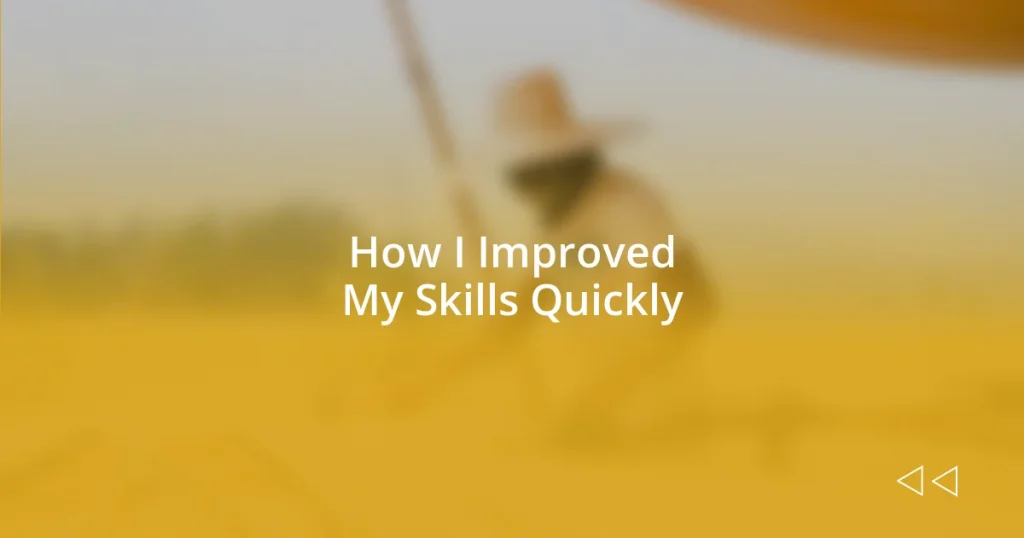Key takeaways:
- Hands-on practice and emotional investment enhance skill development, as community support and passion boost confidence and learning effectiveness.
- Setting specific, measurable, and realistic goals, along with regular reflection, keeps motivation high and directs efforts during skill development.
- Feedback, mentorship, and maintaining a positive mindset are crucial for growth; celebrating small wins and surrounding oneself with positivity fosters resilience and insight.

Understanding Skill Development
Skill development is a journey unique to each person, and I find that understanding my own learning style made a world of difference. For example, I often grappled with concepts until I finally embraced hands-on practice. There’s something magical about diving into an activity—the moment you stop just thinking and start doing transforms the entire learning experience. Have you ever felt that shift?
Reflecting on my early challenges, I remember struggling with public speaking. It wasn’t until I joined a local club that I realized skill development thrives in community. Engaging with others not only provided me with invaluable feedback but also offered a support network that gave me the confidence to step onto the stage. Aren’t those interactions what fuel our growth?
Lastly, it’s important to recognize that emotional investment plays a significant role in skill development. When I immersed myself in topics I was passionate about, I found that learning came effortlessly. I often ponder: How many times have we pushed ourselves through mundane tasks, only to realize that our true potential lies in the things we genuinely enjoy?

Setting Clear Goals
Setting clear goals has been pivotal in my skill development journey. I remember when I decided to enhance my writing skills. Initially, I had a vague idea of wanting to be a better writer, but once I set a specific goal to write one article a week, everything changed. Suddenly, I had direction. I started mapping out topics, deadlines, and even the emotions I wanted to convey. It’s incredible how clarity in goals can energize your efforts.
Here’s how I approach setting clear goals:
- Be Specific: Instead of saying, “I want to get better at photography,” I specify, “I want to master portrait photography by capturing at least five portraits every month.”
- Make It Measurable: I track my progress. For example, I use a checklist to mark off each article I write weekly.
- Set Realistic Benchmarks: While I aim high, I keep it attainable. I once aimed to write a book in a month and quickly realized that setting smaller milestones was key to managing my time and avoiding burnout.
- Establish a Timeline: Deadlines create urgency. I usually give myself a month to see progress, allowing for adaptation if needed.
- Reflect and Adjust: Every few weeks, I review my goals. I ask myself: What worked? What didn’t? This reflection has often led me to recalibrate my objectives towards better outcomes.
In my experience, this approach to goal-setting not only keeps me on track but also fuels my motivation. How do you set your goals?

Creating a Learning Schedule
Creating a learning schedule has been one of the most transformative steps in my skill development process. I recall a time when I’d sit down to learn new concepts, only to find myself distracted within minutes. That’s when I realized I needed a structured approach. I started by allocating specific time slots each day dedicated to my learning activities. Feeding this routine not only instilled discipline but also helped me cultivate a purposeful atmosphere. Have you ever noticed how setting aside time specifically for learning frames your mindset?
When curating my learning schedule, I make it flexible yet consistent. For instance, I blocked out mornings for deep-focus tasks, typically when my mind is freshest. Meanwhile, I reserve evenings for more relaxed learning through podcasts or videos. Since implementing this, I’ve noticed that my retention skyrocketed; the information stuck with me like never before. It’s fascinating how a well-planned schedule can align perfectly with your energy levels, isn’t it?
Lastly, I’ve learned the importance of reviewing and adjusting my schedule regularly. What once worked may not always fit my evolving interests or commitments. For example, I found myself needing more creative time, so I tweaked my schedule to incorporate brainstorming sessions. The beauty of this approach lies in its adaptability, allowing me to remain engaged without feeling overwhelmed. How do you approach your own scheduling to ensure it remains effective?
| Component | Description |
|---|---|
| Time Blocks | Designate specific periods for focused learning. |
| Flexibility | Adjust your schedule based on energy and learning needs. |
| Regular Review | Evaluate and modify your schedule for optimal engagement. |

Utilizing the Right Resources
Utilizing the right resources has been a game-changer in my skill development journey. I remember when I first dove into graphic design, often feeling overwhelmed by the sheer volume of tutorials available. Instead of floundering, I honed in on a couple of respected platforms, like Adobe’s own resources and Skillshare, which offered structured courses that guided me step-by-step. It was through focused learning that I truly grasped the essentials, rather than getting lost in endless content.
I also discovered the value of community resources. Joining online forums and social media groups allowed me to connect with others who were on the same path. I recall a late-night chat in a design group where someone shared their struggles with color theory. It hit home for me, and soon after, I found various free resources and articles that clarified concepts I had previously found confusing. Isn’t it amazing how collaboration can illuminate the learning experience?
Finally, I can’t stress enough the importance of curating a personal library of resources. I’ve gathered e-books, podcasts, and even templates that resonate with my style and learning preferences. I once stumbled across a podcast that dissected famous designs, which not only entertained me but also inspired my own creativity. Have you ever thought about how having a go-to collection of materials can streamline and enhance your learning?

Tracking Your Progress
Tracking my progress has been a revelation in my journey of skill development. When I first started, I often felt like I was swimming without direction. One day, I decided to keep a simple journal to log my daily learning experiences and milestones. At first, it seemed like an extra task, but over time, I noticed that writing down even the smallest achievements, like completing a challenging module, gave me a rush of motivation. Do you find that reflecting on your daily progress energizes you, too?
As I delved deeper, I discovered the power of visual tracking methods. I created a colorful chart that displayed my skill levels and competencies. Watching my progress grow from just a dot to a bold line over weeks was oddly satisfying. It became a form of art, and I found myself excited about updating it regularly. Isn’t it fascinating how such a simple visual representation can make such a big difference in how motivated you feel?
Recently, I implemented a weekly review process that checks both my achievements and areas for improvement. Each Sunday, I take time to assess where I excelled and what needs more attention. There was this moment after a particularly grueling week when I felt disheartened about not mastering a skill as quickly as I wanted. However, looking at my progress chart helped remind me of how far I’ve come. Have you ever experienced a similar moment where reflecting on your journey brought you back to a place of clarity?

Seeking Feedback and Mentorship
Seeking feedback and mentorship has been one of the cornerstones of my skill improvement. I remember approaching a senior designer for critique on a project I was particularly proud of. The initial nerve-wracking moment of handing over my work was soon followed by thrilling insights that opened my eyes to areas I hadn’t considered. Have you ever felt that rush of realizing how much you can grow through someone else’s perspective?
Finding the right mentor can be a transformative experience. In my case, I was fortunate to have a local design expert who was willing to guide me. During our weekly meetings, she didn’t just look at my designs; she asked probing questions that made me rethink my design choices. Those conversations felt like a brainstorming session, sparking ideas I wouldn’t have generated alone. Don’t you think that kind of dialogue can elevate your thinking?
Moreover, I’ve learned that feedback is not just about what’s wrong but also recognizing what’s right. After submitting a piece to an online critique group, I received a blend of encouragement and constructive criticism—each comment felt like a stepping stone. I still recall the moment a stranger pointed out a unique element in my design that I hadn’t even noticed myself. Doesn’t it amaze you how sometimes, an outside perspective can help us see our blind spots and push us toward improvement?

Maintaining a Positive Mindset
Maintaining a positive mindset has been crucial in my skill development journey. I remember a time when I faced significant setbacks, like forgetting key techniques I had just learned. Instead of spiraling into frustration, I shifted my focus to celebrating the small wins, such as mastering a single concept. It’s incredible how a tiny change in perspective can transform your experience. Have you ever found that celebrating the little victories gives you the boost you need?
One practice that has genuinely uplifted my mindset is daily affirmations. I started reciting positive statements like, “I am capable of mastering this skill” each morning. I often felt silly at first, but over time, I noticed a palpable shift in my confidence. This simple routine made me more resilient in the face of challenges. Have you tried affirmations, and if so, how do they help you stay motivated?
Surrounding myself with positivity has also played a pivotal role. I intentionally curated my environment by following inspiring accounts on social media and reading uplifting books. These small changes kept my spirits high and reminded me that progress is often a gradual process. Have you considered how the influences around you shape your mindset? I’ve learned that a supportive community can make all the difference, especially when the path gets rocky.















